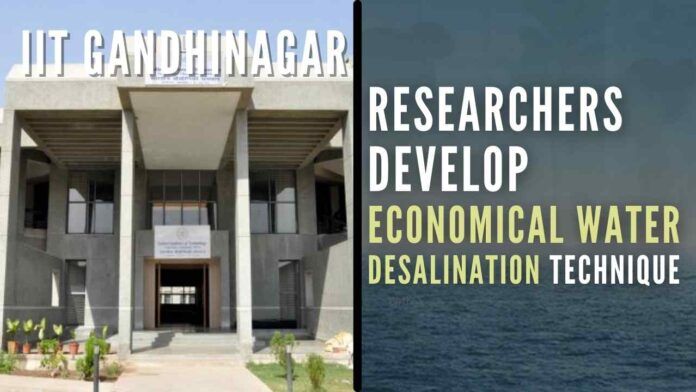
Cost-effective water desalination method developed by IIT Gandhinagar
Taking inspiration from the tree’s natural intake of water that uses the capillary effect, a team of researchers at the Indian Institute of Technology, Gandhinagar (IITGN) have developed a cost-effective and environment-friendly water desalination technique.
Motivated to find an alternative and affordable solution to these issues, a research team led by Gopinadhan Kalon, Assistant Professor, Physics and Materials Engineering, IITGN, created a desalination technique which has flow rates comparable to RO technology, that, too, without using electricity, involving fewer process filters and less wastage of water.
The research team, which includes IITGN Ph.D. scholars Lalita Saini, Aparna Rathi, Suvigya Kaushik, and a Postdoctoral fellow Siva Sankar Nemala, was inspired by the trees’ natural intake of water that uses the capillary effect.
This method developed by the team of IIT researchers can successfully remove more than 99 percent of salt ions and other impurities with natural processing to make seawater potable.
The widely used reverse osmosis (RO) technique for desalination is expensive, wastes more water, and is highly energy-intensive, which typically requires hydrostatic pressures of 60-80 bar.
The water evaporation and water filtration processes used in this technique do not involve any electricity. Selective transport of molecules and ions is commonly observed in biological systems. The research team used the capillary process in the technique, which does not cost any energy, and the evaporation of water happened spontaneously without the need for any external pressure.
The evaporation rates provided a back-calculated pressure of 50-70 bar arising from the capillary and other forces that are present inside the nanoscale channels.
Explaining the technique further, the first author of the research paper, Lalita Saini,
said, “Natural graphite is not absorptive to water or any ions, including protons. However, by its nature, the graphite crystal also does not allow any water molecules to pass through it because there is not enough space for the movement of these molecules.”
“This issue was solved by using an electric field and inserting potassium chloride ions in it, which create some space inside the graphite crystal and provide a stable structure for easy passage of water molecules, at the same time hindering the movement of any salt ions and providing drinkable water,” Saini added.
The researchers found that this technique is self-sufficient and can successfully remove more than 99 percent of salt ions and other impurities from seawater, making it completely safe for drinking. Moreover, carbon materials like graphite are anti-microbial, reducing the number of filters required in the desalination process.
Carbon is abundant in nature and India is the second-largest producer of graphite in the world. The current experiment has utilized natural graphite. However, the team is also devising a method that does not require the use of natural graphite; instead, they can synthesize graphene (one-unit layer of graphite) from waste, plastics, wheat, sugar, chocolate, etc., and assemble it to make the graphite-like structure.
The water evaporation and filtration processes used in this technique do not involve any electricity, and therefore it does not produce any gas emissions, making it environment-friendly. The team is now working to develop a direct point-of-use water filter using this technique to make it accessible for the people.
Explaining the significance and usefulness of this innovation in future applications, Gopinadhan Kalon said, “Our method is not only limited to graphite but also to a large number of layered materials like clay that could be explored for high-performance separation applications. With abundant seawater and appropriate plant design optimization, our method holds a bright future in realizing the dream of drinking water for everyone on the planet.”
Moreover, this technique can also prove to be useful in designing filters for gas purification, proton exchange in a fuel cell, chemical separation, recovery of precious metal from waste, etc.
[With Inputs from IANS]
PGurus is now on Telegram. Click here to join our channel and stay updated with all the latest news and views
For all the latest updates, download PGurus App.
- JP Morgan CEO lauds economic reforms by Modi govt; says PM Modi lifted 400 mn people out of poverty - April 24, 2024
- India, Japan hold talks on Disarmament, Non-Proliferation and Export Control - April 24, 2024
- After backlash over Sam Pitroda’s inheritance tax comment, Congress distances itself saying his views not always aligned with party - April 24, 2024







